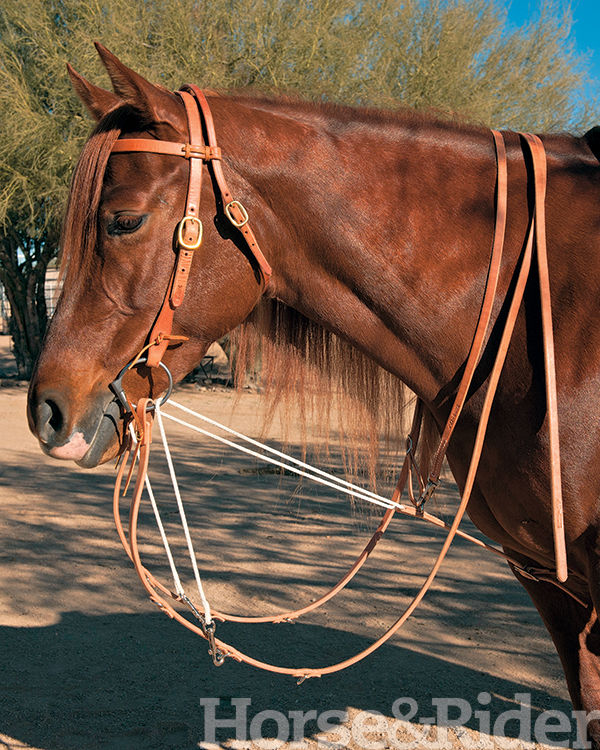A German martingale helps a high-headed or pushy horse get into a better frame by drawing the horse into a more favorable working position, with a flexed poll. I use a German martingale on horses at all stages of life, from 2-year-olds that have the basics down to older horses, and in all different disciplines. Here I’ll explain the German martingale setup, how it works, and correct uses.

Modern Setup
My original German martingale was made completely of harness leather. I had a really good cutting mare that, when I used it on her and dropped my hand, the German martingale flopped around more than I liked. I thought nylon cord running from the reins through the bit might alleviate that problem, so I had one made. The setup was lighter and didn’t flop around when I had slack in my reins. The reins themselves are made of the same leather as the reins I show in, which I like so I don’t lose the feel. My setup has a strap around the neck so that when I lower my hand, my martingale doesn’t get too low.
Adjustment and How It Works
You can see above that the German martingale has an adjustable strap that runs between the horse’s front legs. The nylon cord forks into a Y at the strap’s end. The cord runs up through the rings of the snaffle or short-shanked bit and down to the reins. Each rein has three rings to which a snap at the end of each nylon cord can attach.
Lengthen or shorten the strap running between the horse’s legs according to the horse’s size. Begin by connecting the cords’ snaps to the first (closest to the bit) rings for the initial adjustment. As your horse becomes accustomed to the action of the German martingale, you can connect the snaps to the second and third rings. When you move the connection farther back on the rein, the poll action increases, asking your horse to give more.
You can use various types of bits with this piece equipment, but I suggest a smooth- or twisted-mouthpiece snaffle or a shanked snaffle.
Purpose and Proper Use
When a horse “roots into the bit” (pushes against the bit’s pressure), is chargey, or even a little high-headed, the German martingale draws his nose into a better frame. Once the horse’s head is in a proper position, the martingale releases and allows you to ride with direct bit contact. The piece’s action is very simple and mild, when used correctly. It’s not like a tiedown that constantly pushes against his nose. It doesn’t dump your horse’s weight on his front end or cause him to break at the withers or excessively lower his head. It helps the horse relax and bend at the poll.
Proper use is key. I rock my hands anytime I use them to cue a horse, but especially when I’m using a German martingale. A steady pull won’t net you optimal results and defeats the purpose of the gear. It also can cause your horse to brace harder against your hands. The German martingale isn’t meant to trap a horse. As with any bit or tool, correct use is all about how softly and steadily you use your hands.
Al Dunning, Scottsdale, Arizona, has produced world champion horses and riders in multiple disciplines. He’s been a professional trainer for more than 40 years, and his expertise has led him to produce books, DVDs, and his own online mentoring program, Team AD International (teamadinternational.com).




